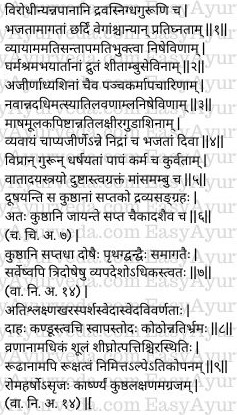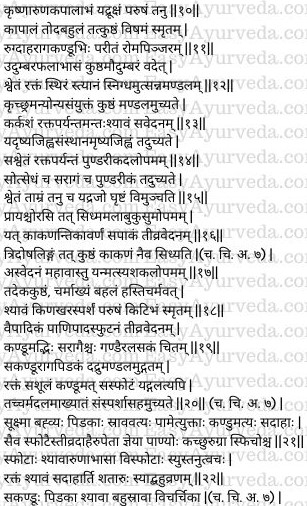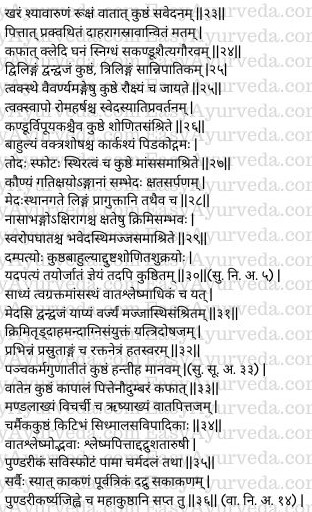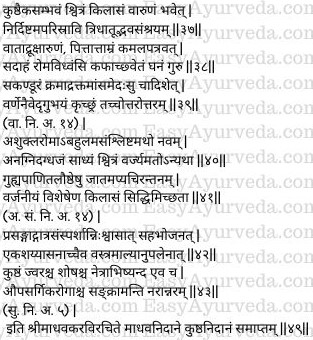
This article explains Madava nidana 49th chapter “Kushta Nidanam”. Causes, pathology and symptoms of Bhagandara are explained in this chapter. Kushta means skin disease.
Nidana, Samprapti
Etiological Factors and Pathogenesis of Kustha
Etiological Factors of Kustha –
- indulgence in incompatible (mutually opposite or antagonistic) foods and drinks,
- excessive intake of foods which are very watery, fatty (unctuous) and heavy (hard to digest),
- suppressing the urges of vomiting and other natural bodily urges,
- doing heavy and excessive physical exercises immediately after taking food and
- too much of exposure to heat (immediately after taking food),
- consuming cold water (immersing in cold water) immediately after exposure to the sunlight (heat of the sun), after doing hard (strenuous) works and after incidents which have caused fear
- use of uncooked foods and over-eating,
- improper methods of administering panchakarma (five purifactory) therapies (emesis, purgation, enema, errhines and bloodletting)
- excessive consumption of fresh grains, curds, fishes, and foods are very salty and sour,
- excessive consumption of black-gram, radish, flours, sesame, milk and jaggery
- indulgence in sexual intercourse while having indigestion
- excessive sleeping during day time (though suffering from indigestion),
- showing disrespect and abusing gods and teachers
- committing many kinds of sinful acts etc
The above-mentioned etiological factors cause abnormal increase of all the three doshas and derangement (contamination) of skin, blood, muscular tissue and body fluids and produce kustha (leprosy, skin diseases). These seven substances (three doshas and four tissues – skin, blood, muscles and fluid components) together cause seven (major, greater) and eleven (minor, lesser) skin diseases. (1-6)
Read – Charaka Kushta Nidana: 5th chapter
Seven types of Kustha
Kustha (leprosy and other skin disorders) is of seven kinds, one from each dosha, three from the combination of two doshas, and one from the combination of all the three doshas together. Though all the kushtas are tridoshaja (caused due to involvement of all the three doshas), the types of kustha are named as vataja, pittaja etc based on the predominance of any one or two doshas in those types of kustha. (The varieties are named to indicate the predominance of a dosha or doshas in the kustha). (7)
Read – Charak Samhita Kushta Chikitsa – 7th Chapter
Kustha Purvarupa
Premonitory symptoms of Kustha
Below mentioned are the premonitory symptoms of Kustha –
- the skin is either very smooth or rough,
- presence or absence of sweating,
- discolouration,
- burning sensation,
- itching,
- loss of sensation in the skin,
- pricking pain,
- appearance of elevated patches,
- giddiness,
- severe pain in the ulcers,
- ulcers form quickly and remain for long periods (does not heal for long periods of time),
- dryness in those ulcers which have healed,
- severe aggravation (re-appearance) of ulcer with trivial (simplest of or feeble) causes,
- horripilation,
- blackish discolouration of the blood (8-9)
Mahakustha
Seven types of major skin disorders and their symptoms
Kapala Kustha – In this condition, the skin resembles a blackish or reddish-brown coloured piece of potsherd (kapala); is dry and rough (coarse) and thin; has severe pricking pain and is intractable.
Udumbara Kustha – This type of kustha resembles the fruit of udumbara (Ficus infectoria) and hence the name. It presents with pain, burning sensation, redness, itching and hairs turned to pink colour.
Mandala Kustha – In this condition, the skin is white or red in colour, tight (hard), moist (wet) and unctuous (oily). It has round and elevated patches which are joined to one another and is difficult to treat.
Rsyajihva Kustha – In this type of Mahakustha, the skin is very rough, is red in colour outside and black inside, and is associated with pain. It resembles the tongue of a black deer (Rsya) and hence the name.
Pundarika Kustha – In this, the skin is white at the centre and red at the edges resembling the petals of the lotus flower, with elevated patches which are red in colour.
Sidhma Kustha – The skin in this condition is white or coppery red in colour. It has thin scales which come off on scratching and are found mainly on the chest. They resemble the flowers of pitcher gourd.
Kakana Kustha – This type of mahakustha has the colour of gunja (Abrus precatorius), undergoing suppuration (pus formation), very painful and caused by all the three doshas and which does not respond to any kind of treatment (incurable). (10-16)
Read – Maha Kushta: Major Skin Diseases, Symptoms, Prognosis
Ksudra kustha
Seven types of minor skin disorders and their symptoms
Ekakustha – In this, there is no sweating, the area of skin involved is large, and the skin resembles the scales of a fish.
Carmakhya Kustha – In this condition, the skin becomes thick like that of an elephant skin.
Kitibha Kustha – The skin in this condition is blackish, rough and coarse just like the scar of a wound (granulation).
Vaipadika Kustha – This type of ksudra kustha presents with cracks and fissures formed on the hands and feet associated with severe pain.
Alasaka Kustha – This presents with nodules which are red in colour and associated with itching.
Dadru Mandala Kustha – In this condition there are raised patches studded with small, itching, reddish papules
Carmadala Kustha – It is a condition in which the skin is studded with red coloured nodules in which there is pain and itching. They burst open and fall off and are sensitive to touch (do not tolerate when touched).
Pama – It presents in the form of small and plentiful pustules from which discharges (exudates) take place. Itching and burning sensation are also present.
Kacchu – This is a condition in which the same pustules (as explained in pama) appear on the hands and on the buttocks associated with burning sensation.
Visphota – This condition presents with boils on the skin which are bluish black or brownish red in colour. It is called Visphota in which the skin becomes thin.
Sataru – This type of kshudra kustha presents with innumerable small ulcers which are red or blackish blue in colour and are associated with severe burning sensation and pain.
Vicarcika – In this condition, black coloured nodules are found from which plenty of copious exudates are discharged. This condition is also associated with itching. (17-22)
(The above eleven kinds are known as Ksudra kusthas i.e. minor leprosies / skin diseases).
Read – Kshudra Kushta: Minor Skin Diseases, Symptoms, Prognosis
Symptoms of Kustha based on the predominance of dosha
Symptoms of vata predominance in all kinds of Kustha include – manifestation of roughness, bluish black or brownish red colour, dryness and pain.
Symptoms of pitta predominance in all kinds of Kustha include – manifestation of putrefaction, burning sensation, redness and exudation (discharges).
Symptoms of kapha predominance in all kinds of Kustha include – manifestation of moistness (wetness), thickness, unctuousness (greasiness), itching, coldness and heaviness.
In dwandwaja Kustha – symptoms of two doshas are manifested together.
In sannipataja Kustha – symptoms of all three doshas are present together. (23-24)
Read – Difference Between Kushta And Visarpa
Dhatugata Kustha Symptoms
Twakgata Kustha – When kustha is located in the skin (rasa tissue) there will be discolouration of the skin, roughness, loss of sensation, horripilation and profuse sweating.
Raktagata Kustha – When kustha is located in the blood, there will be itching and the appearance of pustules in large numbers / foul smelling pus formation.
Mamsagata Kustha – When kustha is located in the muscle tissue, there will be the appearance of thick elevated patches, dryness of the mouth, roughness, appearance of nodules, pricking pain, boils / blisters and tightness of the skin.
Medogata Kustha – When kustha is located in the fat tissue, the fingers will fall off, and there will be loss of movements in the body parts (inability to walk), splitting pain and spreading of ulcer.
Asthi-Majjagata Kustha – When kustha is located in the bones and bone marrow, there is loss of / falling of nose, redness of the eyes, appearance of worms in the ulcers and loss of voice.
Shukragata Kustha – When the couple suffer from kustha, the child produced by them will also be born with kustha since both sperm (of the man) and ovum (of the woman) are both affected by kustha. (25-30)
Read – Dhatu Gata Kushta: Skin Diseases Rooted In Different Tissues
Prognosis of Kustha
Kustha is located (invading) in skin, blood and muscle tissues and those varieties which are caused by the predominance of vata and kapha are easy to cure.
Kushta located (invading) the fat tissue and those caused by combination of two doshas together become manageable (chronic – curable but needs treatment throughout the life).
Kustha is located (invading) in the bone marrow and bones should not be treated (because they are incurable). (31)
Symptoms which are fatal in Kustha
Kustha is going to kill the patient in the presence of the below mentioned symptoms / conditions –
- presence of worms in the ulcers,
- thirst,
- burning sensation,
- poor digestive capacity
- involvement of all the three doshas together (in the causation of kustha – tridoshaja kustha)
- mutilation, loss of and decaying of body parts
- redness of the eyes
- loss of voice
- if the cure is beyond the capacity of panchakarma (cannot be cured in spite of administering the five purifactory therapies or the patients not suitable to undergo these therapies which are otherwise highly beneficial) (32)
Read – Atopic Dermatitis – Charmadala Kushta: Case Study
Dosha relation in each kustha
Kapala kustha is produced by vata predominance.
Udumbara Kustha is caused by pitta predominance.
Mandala Kustha and Vicarcika Kustha are caused by kapha predominance.
Rsyajihva Kustha is caused by predominance of vata and pitta together.
Carmakhya Kustha, Eka Kustha, Kitibha Kustha, Sidhma Kustha, Alasa Kustha, Vipadika Kustha – all these are caused by predominant vitiation of both vata and kapha together.
Dadru Kustha, Sataru Kustha, Pundarika Kustha, Visphota Kustha, Pama Kustha and Carmadala Kustha – all these are caused by predominance of both kapha and pitta together.
Kakana Kustha is caused by vitiation of all the three doshas together.
The first three types of Kustha i.e. Kapala, Udumbara and Mandala and Dadru, Kakana, Pundarika and Rsyajihva – these seven types are called as Mahakusthas. (33-36)
Kilasa Kustha
Svitra, Kiläsa and Aruna are the variants of Kustha. They are produced by the same causative factors which cause kustha (leprosy).
There is no production of exudates in this condition (no discharges) and are caused by vitiation of all the three doshas together.
Vata predominance in these conditions causes roughness and pinkish discolouration.
Pitta predominance would present with lesions which are red like the petals of a lotus, associated with burning sensation and destruction (loss) of body hairs.
Kapha predominance in these conditions causes whitish discolouration, thickness, feeling of heaviness and itching.
Kilasa is of three types – Aruna, Tamra and Sveta. They are manifested in the blood, muscles and fat tissues respectively. (Involvement of blood causes aruna with pinkish or brownish red or golden yellow discolouration, Involvement of muscles causes tamra i.e., coppery discoloration and involvement of fat tissue will cause sveta i.e., whitish discoloration). The successive kinds are more dreadful than their preceding ones. Kilasa caused by ulcers and doshas will become incurable in successive (deeper) tissues. (37-39)
Read – Kilasa Kushta: Types, Symptoms, Prognosis
Sanskrit Versus




Prognosis of Svitra / Kilasa
Svitra (leucoderma) in which the hairs are not white; the skin is not thick, the patches are not joined together, which is of recent origin and that which has not been caused by burns are curable. Those having symptoms opposite to these are said to be incurable.
The physician desirous of success should refuse treating kilasa which has been manifested over the genitals, palms of the hands, soles of the food and lips and those which have persisted for a long time (chronic cases). (40-41)
Read – Kitibha and Ekakushta: Symptoms, Treatment, Medicines
Aupasargika Roga
Sexual intercourse, physical contact, contact with expired air, dining together, sleeping together, and sharing the dress and garlands / ornaments, diseases like leprosy (skin diseases), fever, tuberculosis and conjunctivitis and many other diseases are transmitted from one person to the other. These diseases are called Aupasargika Rogas (infectious / contagious diseases). (42-44)
Thus ends the chapter on Kustha Nidanam in Madhava Nidana text written by Acharya Madhavakara.










